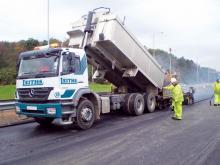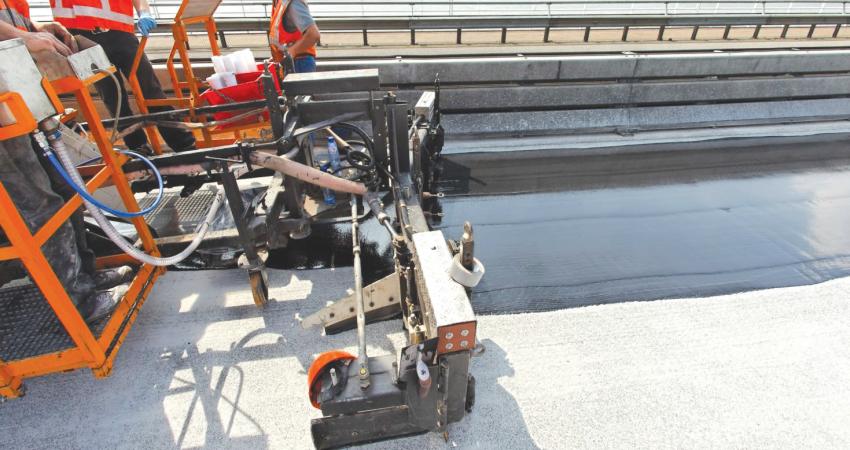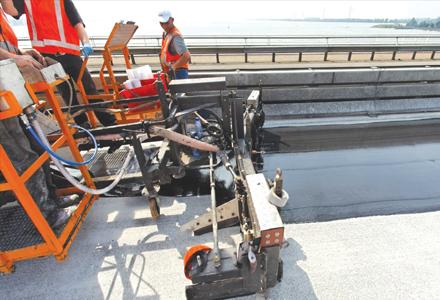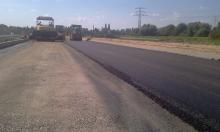
Early evaluation of surfacing work on the M90 at Rosyth – the first major application of Scotland’s new TS2010 specification – has earned positive praise
The M90 works – known as the Fife Intelligent Transport System (ITS) contract – is one of three elements of the Forth Replacement Crossing project. The other legs are the new bridge plus approach roads, and a major upgrade of the M9’s junction 1a at Kirkliston.
Fife ITS has been all about converting 3.8km of the existing M90 into ‘managed motorway’, installing gantries and ITS equipment to control and direct traffic flows heading south to the Forth Road Bridge and north from it.
The £12.8 million design and build contract involved the upgrading of the southbound M90 hard shoulder (to serve as a bus lane) plus associated pavement works (which included total resurfacing of the carriageway). It is the carriageway works that proved quite a challenge – in terms of materials design, application, planning, resourcing and not least, overall conformance to TS2010.
Transport Scotland’s materials and QA advisor Dougie Millar has had much to do with the new specification. As he said: “It has ensured that this section of M90 carriageway resurfaced is resilient, should serve a long time and provide beneficial surface characteristics from day one.” He added that an application of grit is ensuring the carriageway has a high standard of early life resistance to skidding.
The standards achieved have been high enough to impress the Scottish Inspection Panel (SIP). A body established in 2008 of surfacing experts – from Transport Scotland,
In service performance is recorded in the panel’s annual report which also aims to identify and track typical modes of failure; and then eliminate these modes. TS2010 is a direct result of a SIP initiative to tackle a perceived lack of durability of SMA thin surfacings. Being only three months old, the M90 works should not really have been in the itinerary but TS2010 having been their baby, panel members could not resist a quick inspection. They were impressed by what they saw, according to Millar.
Motorists using the M90 were likewise impressed over two weekends earlier in the spring, by the scale and speed of operation when the actual carriageway surfacing works were carried out. It is not often that three pavers can be seen laying asphalt in echelon on British roads so when it happens it generates attention. The reason that multi paver surfacing was used on the M90 is simple: Transport Scotland does not favour longitudinal joints in its super new pavement.
No joints means no path through which water can pass, eliminating a possible weak spot from the start. Preventing water ingress is only a small part of the story, however: TS2010 is intended to maximise the return on the Scottish Government’s investment by minimising premature failure and subsequent interventions.
“The M90’s surfacing has been laid to last and be safe from the off,” said Breedon Aggregates Scotland contracts director Kevin Carmichael. Breedon is the surfacing subcontractor, working out of its base in Fife. “Paving in echelon as we did required great care and so did the compaction and gritting that followed on immediately behind the pavers.”
The principal contractor on the Fife ITS contract was
The target was to achieve consistent structural competency of the carriageway, across all three lanes. This included areas of total reconstruction of the original hard shoulder.
All this meant a thorough survey involving visual inspection, FWD (falling weight deflectometer) analysis and the testing of cores. Eventually a high quality EME2 high modulus asphalt was chosen for the base, binder and regulating layers, with a TS2010 compliant mix from Breedon specified for the surfacing.
The path to obtaining official approval for a TS2010 mix is comparatively long and exacting and follows a course dictated by the specification’s required TAIT, or type approval installation trial. This has four stages, the first three intended to ensure that the fourth – proofing the material at two years – never produces a negative result.
First is the design stage, very much to the TS2010 specification. Then comes a plant trial, where the designed material is mixed; laid both with grit and without grit; and then put to the test, both destructively and non-destructively. This last is a crucial element. The test results are correlated to make the non-destructive testing comprehensively meaningful. The intention is that tests in the field can subsequently be carried out just by using non-destructive methods without the necessity to take cores, for example, from sound carriageway.
Stage three is a network trial, where 20tonnes or so of the design mix is laid within the carriageway of a live road, to measure in particular skidding resistance. “We chose a non-event area for this particular stage,” said Millar. Stage four is the aforementioned proofing at two years. Transport Scotland supervises the TAIT process, making sure that the laying contractor and its staff know what is being done and why it’s being done.
“Knowledge transfer is the key to better application of technology,” Millar said. “We provide advice and guidance about laying TS2010 material too: there’s no point in getting everything right at the design stage if you don’t lay the material properly.”
For the M90 TS2010 mix the aggregate used was of 10mm nominal size and of varying PSV, to suit different areas of application. Approaches to junctions for example had stone of 68PSV while the lesser stressed areas had 60PSV. The binder was Nypol 103, supplied by
Nynas also supplied the bitumen that went into the job’s EME2 asphalt mixture, the chosen binder being Nypave FX 20. This according to Hardy is a hard paving grade bitumen specially developed for use in high modulus asphalts such as EME2.
Project details
Forth Replacement Crossing – intended to provide a long term crossing of the Firth of Forth (the existing bridge showing signs of deterioration); made up of three contracts.
1. Fife ITS design and build contract, described above. Principal contractor GRAHAM Construction. Designer Mouchel. Principal asphalting contractor Breedon Aggregates (Scotland). Value: £12.8M. Completion: late summer 2012.
2. New Forth Road Bridge and connecting roads. Principal contractor Forth Crossing Bridge Constructors (a consortium of Hochtief, Morrison Construction, American Bridge and Dragados. Value: £790M. Completion 2016.
3. Upgrade of the M9 junction 1a at Kirkliston. Principal contractor: John Sisk and Roadbridge. Value: £25.6M. Completion spring 2013.There was an “exceptionally high level of cooperation” between all parties to the contract, the planning of the surfacing logistics requiring a high degree of effort. The carriageway asphalting work as a whole, along with its allied traffic management, could be described as a logistical challenge according to Millar.
Traffic management was carried out 24/7 by GRAHAM Highway Management Maintenance (HMM). Two way traffic had to be maintained at all times and contraflows were put in place to allow full closure of the southbound carriageway, the surfacing having to be carried out in one pass at weekends.
“Normally we wouldn’t have had full closure,” said Millar, “possession would have been much more piecemeal, more disruptive, more expensive and taken longer. As it was, the work was scheduled to be done over four weekends and GRAHAM and its team managed to get that down to just two.
“That said, Breedon did particularly well and praise should go to the company. The asphalting was carried out superbly and TS2010’s first major use seems to be a resounding success.”











